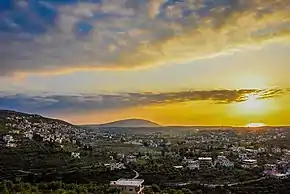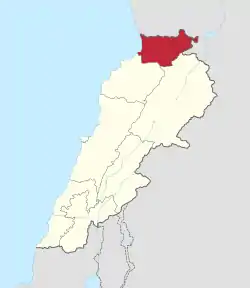Akkar Governorate
Akkar Governorate (Arabic: محافظة عكار) is the northernmost governorate of Lebanon. It comprises the single district of Akkar,[3] which in turn is subdivided into 121 municipalities.[1] The capital is at Halba.[3] It covers an area of 788 km2 (304 sq mi)[1] and is bounded by the Mediterranean Sea to the west, North Governorate to the south, Baalbek-Hermel Governorate to the southeast, and the Syrian governorates of Tartus and Homs to the north and northeast. The governorate's western coastal plain constitutes Lebanon's second largest agricultural region after the Beqaa Valley, while the east features forested mountains that have been considered for protection as a national park.[4]
Akkar
Arabic: محافظة عكار | |
|---|---|
 Berkayel, Akkar Governorate | |
 Location of Akkar Governorate in Lebanon | |
| Coordinates: 34.5°N 36.2°E | |
| Country | |
| District | Akkar District |
| Municipalities | see list |
| Gazetted | 16 July 2003 |
| Capital | Halba |
| Government | |
| • Governor | Imad Labaki |
| Area | |
| • Total | 788 km2 (304 sq mi) |
| Population | |
| • Estimate (31 December 2017)[2] | 423,596 |
| Time zone | UTC+2 (EET) |
| • Summer (DST) | UTC+3 (EEST) |
The UNHCR estimated the population of the governorate at 389,899 in 2015, including 106,935 registered refugees of the Syrian Civil War and 19,404 Palestinian refugees.[1] The population is predominantly Sunni Muslim around 70-75% with a minority of Christian and Alawite communities and very few Shiites.[1] Akkar is Lebanon's least urbanized governorate, with 80% of the population living in rural areas.[5]
Akkar Governorate was created by the enactment of Law 522 on 16 July 2003, in which Akkar District was separated from North Governorate.[6] Implementation of the new region only began in 2014 with the appointment of the first and current governor, Imad Labaki,[7] and remains incomplete as of 2017.[8] Historically marginalized and neglected by the central government, Akkar is Lebanon's poorest region and has the country's highest illiteracy rate, and suffers from lack of basic infrastructure and services.[5] The recent influx of Syrian refugees has exacerbated these problems, with the unemployment rate in the governorate reaching almost 60% in 2015.[9]
References
- "Akkar Governorate Profile". UNHCR. June 2015. Retrieved 19 February 2017.
- Brinkhoff, Thomas (2 March 2019). "Lebanon: Administrative Division". City Population. Retrieved 3 July 2021.
- "Mohafazah de Aakkar". Localiban. Archived from the original on 26 September 2017. Retrieved 19 February 2017.
- "Towards a National Park in Upper Akkar" (PDF). Mada. March 2009. Archived from the original (PDF) on 13 September 2016. Retrieved 20 February 2017.
- Mouchref, Aicha (January 2008). "Forgotten Akkar: Socio-Economic Reality of the Akkar Region" (PDF). Mada. Archived from the original (PDF) on 10 September 2016. Retrieved 20 February 2017.
- "Territorial administration of Lebanon". Localiban. Archived from the original on 8 October 2018. Retrieved 19 February 2017.
- "Cabinet Appoints 5 New Governors, Accepts Qaloush's Resignation". Naharnet. 2 May 2014. Retrieved 19 February 2017.
- Obeid, Ghinwa (9 February 2017). "Akkar governorate in dire need of security and development". The Daily Star. Retrieved 19 February 2017.
- "North and Akkar Governorates Profile". UNHCR. 2016. Archived from the original on 26 December 2017. Retrieved 19 February 2017.
